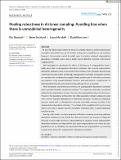Files in this item
Pooling robustness in distance sampling : avoiding bias when there is unmodelled heterogeneity
Item metadata
| dc.contributor.author | Rexstad, Eric | |
| dc.contributor.author | Buckland, Stephen Terrence | |
| dc.contributor.author | Marshall, Laura Helen | |
| dc.contributor.author | Borchers, David | |
| dc.date.accessioned | 2023-01-06T15:30:10Z | |
| dc.date.available | 2023-01-06T15:30:10Z | |
| dc.date.issued | 2023-01-06 | |
| dc.identifier | 282829174 | |
| dc.identifier | b4f702bf-cfd7-4690-963e-892488340f74 | |
| dc.identifier | 85147157127 | |
| dc.identifier.citation | Rexstad , E , Buckland , S T , Marshall , L H & Borchers , D 2023 , ' Pooling robustness in distance sampling : avoiding bias when there is unmodelled heterogeneity ' , Ecology and Evolution , vol. 13 , no. 1 , e9684 . https://doi.org/10.1002/ece3.9684 | en |
| dc.identifier.issn | 2045-7758 | |
| dc.identifier.other | RIS: urn:C7895DAEA42D409FE0BBA623D2897BD8 | |
| dc.identifier.other | ORCID: /0000-0002-9939-709X/work/126031608 | |
| dc.identifier.other | ORCID: /0000-0002-4323-8161/work/126031862 | |
| dc.identifier.other | ORCID: /0000-0002-3944-0754/work/126031959 | |
| dc.identifier.uri | https://hdl.handle.net/10023/26703 | |
| dc.description.abstract | The pooling robustness property of distance sampling results in unbiased abundance estimation even when sources of variation in detection probability are not modeled. However, this property cannot be relied upon to produce unbiased subpopulation abundance estimates when using a single pooled detection function that ignores subpopulations. We investigate by simulation the effect of differences in subpopulation detectability upon bias in subpopulation abundance estimates. We contrast subpopulation abundance estimates using a pooled detection function with estimates derived using a detection function model employing a subpopulation covariate. Using point transect survey data from a multispecies songbird study, species-specific abundance estimates are compared using pooled detection functions with and without a small number of adjustment terms, and a detection function with species as a covariate. With simulation, we demonstrate the bias of subpopulation abundance estimates when a pooled detection function is employed. The magnitude of the bias is positively related to the magnitude of disparity between the subpopulation detection functions. However, the abundance estimate for the entire population remains unbiased except when there is extreme heterogeneity in detection functions. Inclusion of a detection function model with a subpopulation covariate essentially removes the bias of the subpopulation abundance estimates. The analysis of the songbird point count surveys shows some bias in species-specific abundance estimates when a pooled detection function is used. Pooling robustness is a unique property of distance sampling, producing unbiased abundance estimates at the level of the study area even in the presence of large differences in detectability between subpopulations. In situations where subpopulation abundance estimates are required for data-poor subpopulations and where the subpopulations can be identified, we recommend the use of subpopulation as a covariate to reduce bias induced in subpopulation abundance estimates. | |
| dc.format.extent | 11 | |
| dc.format.extent | 750975 | |
| dc.language.iso | eng | |
| dc.relation.ispartof | Ecology and Evolution | en |
| dc.subject | Abundance estimation | en |
| dc.subject | Detectability | en |
| dc.subject | Distance sampling | en |
| dc.subject | Heterogeneity | en |
| dc.subject | Pooling robustness | en |
| dc.subject | QA Mathematics | en |
| dc.subject | QH301 Biology | en |
| dc.subject | DAS | en |
| dc.subject | MCC | en |
| dc.subject.lcc | QA | en |
| dc.subject.lcc | QH301 | en |
| dc.title | Pooling robustness in distance sampling : avoiding bias when there is unmodelled heterogeneity | en |
| dc.type | Journal article | en |
| dc.contributor.institution | University of St Andrews. School of Mathematics and Statistics | en |
| dc.contributor.institution | University of St Andrews. Applied Mathematics | en |
| dc.contributor.institution | University of St Andrews. Centre for Research into Ecological & Environmental Modelling | en |
| dc.contributor.institution | University of St Andrews. Institute of Behavioural and Neural Sciences | en |
| dc.contributor.institution | University of St Andrews. Statistics | en |
| dc.contributor.institution | University of St Andrews. Scottish Oceans Institute | en |
| dc.contributor.institution | University of St Andrews. Marine Alliance for Science & Technology Scotland | en |
| dc.identifier.doi | https://doi.org/10.1002/ece3.9684 | |
| dc.description.status | Peer reviewed | en |
This item appears in the following Collection(s)
Items in the St Andrews Research Repository are protected by copyright, with all rights reserved, unless otherwise indicated.

